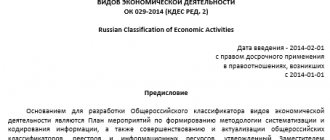OKVED is equally applicable to all enterprises and organizations, regardless of their legal form.
That is, CJSC, individual entrepreneur, LLC reflect the same digital codes in their title documents.
The procedure for selecting classification ciphers is mandatory for all commercial companies and has no exceptions.
When studying and entering OKVED digital codes into the registration application, many novice entrepreneurs unknowingly make a number of mistakes. In order to help avoid them, we’ll talk in detail about what to rely on and in what order to act when choosing codes from the all-Russian classifier.
- Not all codes are equivalent when entered into the constituent documents of an enterprise or individual entrepreneur. The first code chosen is considered the main one, since it must correspond to the type of activity that is prioritized at the enterprise. All other codes play an additional role and are of a secondary nature. Every organization must have at least one code from OKVED; without it, registration with the state is simply impossible;
- All actually and formally possible types of economic activity carried out on the territory of Russia have their own special digital designation, which is included in OKVED. In turn, OKVED consists of sections and subsections, groups and subgroups. When choosing digital ciphers, you should go from large to small. That is, you need to start by defining the scope of activity, and gradually, through sections and groups, reach any specific type of activity. At the same time, you need to try to select codes so that they correspond as much as possible and reflect the essence of the actual work performed and services provided;
- The digital code from OKVED allowed for registration must consist of at least 3 characters. 3 numbers imply a subclass of the section and, as a rule, they are chosen by those entrepreneurs who do not want to limit their actions within this section in any way. However, it is still preferable to specify four-digit ciphers that are narrower in terms of practical application;
- If suddenly a newly created organization plans to engage in those works or services that, under Russian law, are subject to mandatory licensing or require special permission, it is best not to act at random, but to consult with specialists. They will help you more accurately designate the name of a particular type of activity and select the correct digital code, which will protect you from all sorts of troubles in the future.
Attention! If problems arise in selecting OKVED codes, it is enough to study Appendix “A” to the classifier. It is an excellent assistant and contains quite detailed explanations for all types of activities.
Decoding OKVED codes and their classification 2022
We talked about the main points that you should pay attention to when choosing codes from OKVED. Now about some of the nuances of choosing types of activities based on digital ciphers from the classifier.
- When choosing OKVED codes, future businessmen, in particular the founders of an LLC, should remember that there must be a 100% coincidence of the types of activities specified in the application and those indicated in the charter, otherwise tax officials can easily refuse registration. But even if the initial stage of registration with the tax service is completed successfully, problems may well arise when opening a bank account, since bank employees check documents no less carefully;
- The law does not in any way limit the number of OKVED codes included in the application for registration of an enterprise. Therefore, businessmen often enter not only those specific types of activities that they actually plan to engage in, but also those that they envision only in theory. The accumulation of codes from the classifier included in title documents entails a number of dangers. Let's give just one fairly common example: some types of activities may be subject to a special UTII tax regime, and in such cases, tax authorities may require an entrepreneur or organization to submit separate reports on them. Thus, experts advise holding back and not adding more than two dozen OKVED codes to the constituent documents and, when choosing them, carefully study the features of each type of activity, including from the point of view of tax legislation;
- It is extremely important to correctly understand and interpret the names of the types of activities listed in OKVED. Otherwise, an incident may arise in which the most necessary and relevant type of activity will not be included in the state register for a given organization or individual entrepreneur. The consequences of such an incident are unpleasant. Firstly, if necessary, it will be impossible to obtain a license, and secondly, it will be impossible to switch to UTII, which operates for strictly defined types of activities at the local and municipal level.
Important! Entering the correct codes from OKVED into the registration documents at the stage of registering an enterprise with state registration is of great importance. If tax specialists discover an error, they will certainly issue an automatic refusal to register. At the same time, the inaccuracy can be corrected, but this will entail new financial and time costs.
Yes, many start-up and existing companies actively use this code to indicate their main or additional type of activity to the tax authorities. Thus, it is used by many intermediary firms engaged in the provision of services related to the organization of purchases and sales of commercial enterprises. It also applies if the company provides services related to assessing the value of elements that are not real estate or insurance.
OKVED 74.84, which will be deciphered both in 2022 and now, includes such activities as modeling products from textile materials, clothing items, and shoes. It is also used when companies model various elements of furniture and interior items. The code 74.84 also reflects activities where premium coupons are used, providing the opportunity to purchase the desired product at a reduced cost or for free.
74 84 OKVED, decoding also reflects the activities of graphic designers. This code is also used by many organizers involved in organizational work related to holding an exhibition, fair or congress. 74.84 also includes design work related to the creation of exhibition stands.
This code also includes agency activities, which provide for such a procedure as concluding an agreement for participation in a theatrical production, film or other events. This code is also used by agencies conducting activities related to copyrights and licenses.
The basic principles of NACE were taken to form OKVED2, namely the hierarchical structure and grouping by classes. The first four characters fully correspond to NACE codes and carry the same position names. A dot is placed between the second and third, fourth and fifth digits, dividing the OKVED code into smaller subgroups. In general, each section of the OKVED 2 code classifier has the following structure:
XX
| Class | |
| XX.X | subclass |
| XX.XX | group |
| XX.XX.X | subgroup |
| XX.XX.XX | view |
Each major section has a letter designation in the Latin alphabet. And within them the above-described structure is observed. Also, comments are provided in the classifier for more accurate transmission of information.
If we talk about what OKVED2 is generally used for, then it is necessary for the classification and coding of various types of economic activities, as well as their detailed decoding.
| A | Agriculture, forestry, hunting, fishing and fish farming |
| B | Mining |
| C | Manufacturing industries |
| D | Providing electricity, gas and steam; air conditioning |
| E | Water supply; water disposal, organization of waste collection and disposal, pollution control activities |
| F | Construction |
| G | Wholesale and retail trade; repair of vehicles and motorcycles |
| H | Transportation and storage |
| I | Activities of hotels and catering establishments |
| J | Activities in the field of information and communication |
| K | Financial and insurance activities |
| L | Real estate activities |
| M | Professional, scientific and technical activities |
| N | Administrative activities and related additional services |
| O | Public administration and military security; social Security |
| P | Education |
| Q | Activities in the field of health and social services |
| R | Activities in the field of culture, sports, leisure and entertainment |
| S | Provision of other types of services |
| T | Activities of households as employers; undifferentiated activities of private households in the production of goods and provision of services for their own consumption |
| U | Activities of extraterritorial organizations and bodies |
OKVED code 74.84 - Provision of other services
Attention! This is an invalid edition. It ceased to be valid on July 11, 2016. Do not use these codes. Get rejected. Use the new OKVED reference books.
This class includes: - collection of payments on accounts, assessment of solvency in connection with the financial condition or business practices of an individual or firm - provision of intermediary services for arranging the purchase and sale of small or medium-sized commercial enterprises, including professional practice - valuation activities not related to to real estate or insurance - modeling of textiles, clothing, shoes, jewelry, furniture, other interior items, as well as other fashion products and goods for personal and household use - activities associated with premium brands (coupons) entitling to a discount or free purchase of goods - activities of graphic designers - activities of organizers of exhibitions, fairs and congresses - activities of exhibition stand designers This group also includes: - activities of agents and agencies carried out on behalf of individuals and usually associated with the conclusion of contracts (agreements) for participation in films , theatrical productions and other entertainment or sporting events - activities of agents and agencies related to copyrights, patents, licenses This group does not include: - activities related to credit cards, see OKVED code 65 - design of industrial premises, including the placement of machinery and equipment, see OKVED code 74.20.12 - placement of advertising and other advertising means, see OKVED code 74.40
This OKVED code does not contain nested codes
See also codes:
- 70.11
— Preparation for the sale of your own real estate - 70.12
— Buying and selling your own real estate - 70.20
— Renting out your own real estate - 70.31
— Activities of real estate agencies - 70.32
— Real estate management - 71.10
— Car rental - 71.21
— Rental of other land vehicles and equipment - 71.22
— Rental of water vehicles and equipment - 71.23
— Rental of air vehicles and equipment - 71.31
— Rental of agricultural machinery and equipment - 71.32
— Rental of construction machinery and equipment - 71.33
— Rental of office machines and equipment, including computer equipment - 71.34
— Rental of other machinery and equipment not included in other categories - 71.40
— Rental of household products and personal items - 72.10
— Consulting on computer hardware - 72.20
— Software development and consulting in this area - 72.30
- Data processing - 72.40
— Activities for the creation and use of databases and information resources - 72.50
— Maintenance and repair of office machines and computer equipment - 72.60
— Other activities related to the use of computer technology and information technology - 73.10
— Research and development in the field of natural and technical sciences - 73.20
— Research and development in the field of social sciences and humanities - 74.11
— Activities in the field of law - 74.12
— Activities in the field of accounting and auditing - 74.13
— Research of market conditions and identification of public opinion - 74.14
— Consulting on business and management issues - 74.15
— Activities for the management of financial and industrial groups and holding companies - 74.20
— Activities in the field of architecture; engineering design; geological exploration and geophysical work; geodetic and cartographic activities; activities in the field of standardization and metrology; activities in the field of hydrometeorologist - 74.30
— Technical testing, research and certification - 74.40
- Advertising activity - 74.50
— Labor recruitment and selection - 74.60
— Conducting investigations and ensuring security - 74.70
— Cleaning and cleaning of industrial and residential premises, equipment and vehicles - 74.81
— Activities in the field of photography - 74.82
— Packaging - 74.83
— Providing secretarial, editorial and translation services
Search for OKVED codes
OKVED
Current OKVED codes for 2022
Name: All-Russian Classifier of Economic Activities Abbreviation: OKVED 2 Designation: OK 029-2014 (NACE Rev. 2) In English: Russian Classification of Economic Activities Responsible: Ministry of Economic Development of Russia Grounds: Order of Rosstandart No. 14-st dated January 31, 2014 Date of introduction : 02/01/2014 End date: not established (no order to cancel the classifier or replace it with a new one) Last change: No. 35, valid from June 1, 2021 Reason for change: Order of Rosstandart dated 04/12/2021 No. 201-st OK 029-2014
developed and presented by the Ministry of Economic Development of the Russian Federation. Built on the basis of harmonization with the official version in Russian NACE Rev.2 (Statistical classification of economic activities in the European Community Rev2 - Statistical classification of economic activities in the European Economic Community (revision 2)).
OKVED contains records of all groupings of types of economic activity, presented hierarchically. To identify groups, each classifier record has a code designation consisting of numbers (from two to six) with a sequential coding method. Dots are placed between the second and third and between the fourth and fifth digits to indicate levels of nesting and have been added to ensure compliance with NACE Rev.2 code entries.
The structure of OKVED 2 is as follows: Section XX - class XX.X - subclass XX.XX - group XX.XX.X - subgroup XX.XX.XX - type
Sections have letter codes of the Latin alphabet, which are not used when constructing code designations (introduced for continuity with NACE Rev.2). Classifier entries may include explanations of what the section/grouping/activity includes and does not include.
List of documents on the implementation, cancellation of the classifier, and the introduction of important amendments. Please note that not all official documents on the classifier are shown, but only the most significant ones.
- Order of Rosstandart dated January 31, 2014 No. 14-st - changes have been made to the document since its publication 1. Adopt OKVED2 OK 029-2014 (NACE Rev. 2), OKPD2 OK 034-2014 (KPES 2008) with the effective date of 01.02 .2014. 2. Cancel OKVED OK 029-2001 (NACE Rev. 1), OKVED OK 029-2007 (NACE Rev. 1.1), OKPD OK 034-2007 (KPES 2002), OKDP OK 004-93, OKUN OK 002-93, OKP OK 005-93 from January 1, 2015.
- Order of Rosstandart of September 30, 2014 No. 1261-st Establish a transition period until January 1, 2016.
- Order of Rosstandart of November 10, 2015 No. 1745-st Establish a transition period until January 1, 2022.
- Order of Rosstandart dated February 17, 2016 No. 41-st. Supplement Order of Rosstandart dated January 31, 2014 No. 14-st with clause 8 on the introduction of collective classification groups.
- Order of Rosstandart dated March 20, 2022 No. 162-st. Supplement Order of Rosstandart No. 14-st dated January 31, 2014 with clause 15 on the introduction of collective classification groups for OKVED 2 and OKPD 2.
Orders relating to changes in the classifier (adding, deleting and adjusting data) are listed in the list of changes tab.
OKVED: 74. Other professional scientific and technical activities
- General information about changes
- Change of LLC director
- Changing activities
- Filling out the new form 14001 (from 07/04/2013!)
- Filling out the new form 13001 (from 07/04/2013!)
- Change of name
- Change of legal address
- Filling out the old form P13001 (until 07/04/2013)
- Filling out the old form P14001 (until 07/04/2013)
- Sale of a share in an LLC: according to the new rules
- Sale of a share to the Company / Alienation of a share of LLC
- Sale of a share in an LLC to another participant
- Sale of a share in an LLC to a third party
- Instructions for re-registration of LLC
- Notarization of a transaction for the sale of a share in an LLC
- Increasing the authorized capital of LLC
- Reducing the authorized capital of an LLC
- Filling out the new form P16003 (came into force on July 4, 2013)
- Change of general director of LLC 2015 step-by-step instructions on Form No. P14001
- Changing the types of activities of an LLC - instructions for filling out Form No. P14001
- Changing the name of an LLC - step-by-step instructions for filling out form No. P13001
- Changing the legal address of an LLC - step-by-step instructions for filling out Form No. P13001
- New procedure for changing legal address from 2016
- Change of LLC director in 2016
- Change of founders and sale of shares in LLC according to new rules
- How to rename an LLC?
- Business merger: nuances of the procedure
- How to sell a stake in a company correctly: a short guide
- Change of founders
- Change OKVED IP
- Making changes to the Unified State Register of Real Estate
- Making changes to the IP
- Amendments to the company's charter
- Making changes to NPOs
- Contribution of real estate to the authorized capital of LLC
- Change of general director of LLC
- Change in the composition of LLC participants
- Changing the surname of an individual entrepreneur
- Notification to the bank about change of legal address
- How to reorganize a company by spinning it off: algorithm of actions
- General information about non-profit organizations
- Registration of non-profit organizations
- Documents for registration of non-profit organizations
- Taxation of non-profit organizations
- NPO reporting: how and where to submit?
- Liquidation procedure for a non-profit organization
- Accounting for contributions to non-profit organizations
- Registration of ANO
- Fund registration
- Register an investment fund
- Registration of a charitable foundation
- Registration of a budgetary institution
- Development of the credit system in Russia
- The concept of a secured loan
- Signs of bank instability
- What to look for when taking out a loan
- All about loan interest
- Consumer loan
- How to calculate loan payments. Loan calculation formula.
- Property tax 2013-2014
- Loans for small businesses, what assistance the state provides
- Methods for market valuation of small business value.
- Overdraft - what is it for business?
- Is it illegal to pay debt collectors or collection agencies?
- How to get an interest-free loan for an individual entrepreneur in a special mode
- Corporate debt 2015 – how to pay it back
- Protection of creditors' rights in bankruptcy
- Beneficiary: definition of the term and scope of its application
- Small business support: how to get government assistance in 2017
- Leasing is a profitable tool for an entrepreneur
- How to choose a servicing bank: main factors
- Tightening liability for illegal currency transactions
- Companies promoting goods and services: comparison of dealers with distributors
- New measures of state support for small enterprises
- New conditions for preferential lending to small businesses
- Ban on returning goods, reduction of fees and other innovations in December
- Renting and leasing: comparative characteristics
- Selling a business: the secrets of a successful deal
- Refusal for a business to open a bank account: main reasons
- Credit or leasing: which purchase method to choose
- Revenue, profit and income: understanding the differences
- Opening an account
- Certificate of opening a bank account
- How to expand your business: effective ways to scale
- Company for rent: how to try your hand at business
- How to register an online cash register: brief instructions
- Pricing: how to choose the right method
- Attracting investment during a crisis
- 08/07/2020 — How much do officials get paid?
- 08/07/2020 — Individual entrepreneurs with employees cannot do without an accountant
- 08/07/2020 — Tax officials uncovered a chain of fraud with scrap metal
- 08/06/2020 — Convicted of treason served half of his sentence and was released on parole
- 08/06/2020 — Muscovites defended the land near their house
- 08/06/2020 — The vice-rector of Moscow State University is suspected of fraud
- 08/05/2020 — In Texas they also violate
OKVED 2 - All-Russian Classifier of Types of Economic Activities
- Calculation of vacation payments in 2014-2015
- How to find out TIN
- Personal income tax refund
- How to write a receipt correctly
- Calculation of maternity payments in 2016
- Maternity capital, child benefits 2013
- How to certify a copy of a document
- Minimum wage (minimum wage)
- Mortgage program for young family
- Mortgage loan repayment deferment
- Changes in maternity capital in 2015-2016
- How to choose a non-state pension fund
- Property tax for individuals - changes in 2015
- Maternity leave - when do they leave and how is it paid?
- New state duties from 2015
- Maternity benefit - calculation procedure when replacing calendar years
- Borrowing money - how to give correctly to get it back
- Bankruptcy of individuals and individual entrepreneurs has been possible since 2015
- Division of property during divorce - how to preserve your interests
- Who cannot be laid off from the company's employees?
- New tariffs and powers of notaries 2015 in the Russian Federation
- Personal income tax in 2015 - what changes have occurred
- How to get a tax deduction for education
- Foreign currency mortgage - what to do in 2015
- Is it possible to refuse loan insurance?
- What can you spend maternity capital on?
- How to get a tax deduction when buying an apartment
- Patent for an individual – legalization of business on preferential terms
- How to find out your own TIN
- Instructions for certifying a copy of a document
- How to properly bring a product (product or service) to the market?
- Recognition of an individual as an entrepreneur: main criteria and consequences
OKVED codes are statistical information intended to inform government authorities what exactly a new business entity plans to do. The codes are indicated in accordance with a special document - the All-Russian Classifier of Types of Economic Activities, which gave the name to the abbreviation “OKVED”.
In 2022, only one edition of the classifier is in force - OKVED-2 (another name is OKVED-2014 or OK 029-2014 (NACE rev. 2)). Classifiers of the OKVED-1 editions (another name is OKVED-2001 or OK 029-2001 (NACE Rev. 1)) and OKVED-2007 or OK 029-2007 (NACE Rev. 1.1) have become invalid since January 1, 2017.
If the applicant enters the codes of the wrong Classifier into the application, he will be denied registration, so be careful! Those who will fill out an application using our service do not need to worry, we have timely replaced OKVED-1 with OKVED-2. The documents will be filled out correctly.
The applicant’s idea of the proposed activity codes does not always coincide with the logic of the structure of the OKVED classifier. For example, it is understandable when it comes to activities related to the rental of apartments and offices. The following OKVED codes are suitable:
- 68.20 Rent and management of own or leased real estate
- 68.20.1 Rent and management of own or leased residential real estate
- 68.20.2 Rent and management of own or leased non-residential real estate
Also, quite logically, activities related to trade or the provision of taxi services are structured. But, for example, a designer associated with Internet advertising can work under the following OKVED codes:
- 18.12 Other types of printing activities
- 74.20 Activities in the field of photography
- 62.09 Activities related to the use of computer technology and information technology, other
- 73.11 Activities of advertising agencies
- 73.12 Representation in the media
- 90.03 Activities in the field of artistic creativity
- 90.01 Performing arts activities
- 62.01 Computer software development
As much as you like, it is not forbidden to include at least the entire Classifier in the application (the only question is how much you need it). In the sheet where OKVED codes are indicated, you can enter 57 codes, but there can be several such sheets, in this case the main type of activity is entered only once, on the first sheet.
Please note that if the OKVED code you have chosen relates to the field of education, upbringing and development of children, medical care, social protection and social services, youth sports, as well as culture and art with the participation of minors, then to register an individual entrepreneur you will need a certificate of no criminal record (clause 1(k) of article 22.1 of law No. 129-FZ). The document is submitted upon an interdepartmental request, but in order not to delay the registration process, you can, after checking with the registration inspection about this possibility, request a certificate in advance.
The law stipulates this requirement only for individuals, that is, individual entrepreneurs, and when registering an LLC such a certificate is not required.
Section G. Wholesale and retail trade; repair of vehicles and motorcycles
- RusTender
- OKVED 2 - All-Russian Classifier of Types of Economic Activities
- Section G. Wholesale and retail trade; repair of vehicles and motorcycles
This section includes:
- wholesale and retail trade (i.e. sale without transformation) of any type of goods, as well as various types of services accompanying the sale of goods. Wholesale and retail trade are the final stages of distribution of goods. This group also includes car and motorcycle repairs. Selling without transformation is usually understood as standard actions (operations) associated with trade, such as sorting, classifying, arranging goods, mixing (stirring) goods (for example, sand), bottling (with or without previous washing of bottles), packaging, separating bulk lots, repackaging into smaller lots for distribution, storage (chilled or frozen products)
The group includes:
- all activities related to the sale and repair of cars and motorcycles, while the groupings include all other activities related to sales
The main difference between grouping (wholesale) and grouping (retail) is based on the predominant type of buyer
Wholesale is the resale (without conversion) of new or used goods to retailers, sales to entities such as industrial, commercial, institutional or professional users, or resale to other wholesalers, or the use of agents or brokers to buy or sell goods
The main types of companies included in the group are commodity wholesalers, i.e. Wholesalers who acquire rights to the goods sold, such as commodity wholesalers or intermediaries, distributors working for manufacturers, exporters, importers and buyer associations, sales offices (but not retail stores) that are supported by manufacturers or extractive enterprises that are not part of them, for marketing purposes and more; accept orders for direct shipments from factories or mines. It also includes brokers, agents, commission agents, buyers and buyer associations associated with the agricultural market. Wholesalers often collect, sort and condition goods in large quantities themselves, break up large ones, and repackage them into smaller lots (for example, medicines). Store, refrigerate, deliver and install products, promote sales and create brands.
45 Wholesale and retail trade in motor vehicles and motorcycles and their repair
46 Wholesale trade, except wholesale trade of motor vehicles and motorcycles
47 Retail trade, except trade in motor vehicles and motorcycles
Share a link to this article






